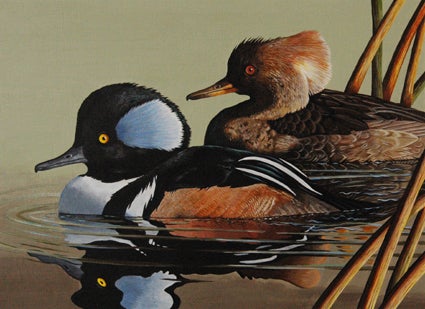SCIENTIFIC NAME:
Lophodytes cucullatus
STATUS:
Rare breeder. Fairly common in winter, spring, and fall, and rare in summer in all regions. Low Conservation Concern.
DESCRIPTION:
The smallest of the three mergansers occurring in North America, the hooded merganser is also the only one restricted to North America. Male hooded mergansers have a large white crest surrounded by black. The top of the head, neck, and back are all black and the chest, breast, and belly are white. Wavy black lines can be seen on the tawny sides and flanks. The hindback, rump, and tail are dark brown. The long narrow serrated bill is black. The iris is bright yellow and the legs and feet are dull yellow. Female hooded mergansers have a gray-brown head and neck with a reddish-brown crest. Gray pervades their neck, chest, sides, and flanks, and brownish-black their back, rump, and tail. The upper bill is black edged with orange and the lower bill is yellow. The legs and feet are greenish in color and the iris is brown.
DISTRIBUTION:
Forested wetlands, brackish estuaries and tidal creeks are preferred wintering habitats. Hooded mergansers winter along the Pacific, Atlantic, and Gulf coasts, mainly from southeastern Alaska to northern Baja California, and New England to Florida and west to northern Mexico. The majority of wintering hooded mergansers occur in the Mississippi Flyway.
HABITAT:
Small, forested, freshwater wetlands with emergent vegetation are the preferred breeding habitat of the hooded merganser. They have been known to breed in more open habitat when nest boxes are available. Low-elevation freshwater lakes, ponds, sloughs, and slow-moving rivers are all used. During migration, they visit a wider range of habitats, and are often found on open water, along river banks, and in coastal bays and tidal creeks. In winter, they are found in woodland ponds and swamps, as well as coastal estuaries, bays, and inlets. While they are found in brackish and salt water, they generally prefer fresh water
FEEDING HABITS:
Hooded mergansers dive in freshwater to feed on small fish, crayfish, other crustaceans, and aquatic insects.
LIFE HISTORY AND ECOLOGY:
Hooded mergansers breed from southeastern Alaska, central British Columbia, and southwestern Alberta to southwestern Oregon, central Idaho, and northwestern Montana; and from central Saskatchewan to Nova Scotia south to Kansas, northern Louisiana, and northern Georgia. Hooded mergansers prefer forested wetland systems where they nest in tree cavities or nest boxes and lay an average of 9 to 11 eggs.
Hooded mergansers are most common in the Great Lakes region and current information suggests a stable, possibly increasing population in some areas. However, data on population size and status are tenuous due to the secretive nature of this species. Historically populations likely suffered from habitat loss.
REFERENCES:
Bellrose, Frank C. 1980. Ducks, Geese and Swans of North America. Harrisburg, PA. Stackpole Books.
Bob Hines. 1978. Ducks at a Distance. Washington D.C. Department of Interior U.S. Fish and Wildlife Service.
AUTHOR:
Chuck Sharp, Wildlife Biologist, Alabama Division of Wildlife and Freshwater Fisheries






